mobile Ansicht, to the English Version tap the flag
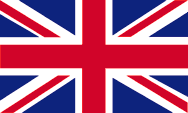

- 1918–1929 Königreich der Serben, Kroaten und Slowenen
- 1929–1941 Königreich Jugoslawien
- 1946–1992 Sozialistische Bundesrepublik Jugoslawien
- 1992–2003 Bundesrepublik Jugoslawien
- 2003–2006 Bundesrepublik Serbien und Montenegro
- ab 2003 bundesstaatliche palamentarische Demokratie
- Eigenbezeichnungen: Jugoslavija, Srbija i Crna Gora
- Name bis 2003: Jugoslawien, übersetzt: Südslawien
• zuletzt verwendete Flaggen
• historische Flaggen
• Bedeutung/Ursprung der Flagge
• zuletzt verwendetes Wappen
• historische Wappen
• Bedeutung/Ursprung des Wappens
• Flugzeugkokarde
• Landkarte
• Zahlen und Fakten
• Geschichte
• regionale Flaggen
– Serbien
– Montenegro
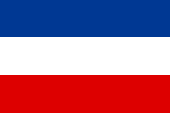
Nationalflagge,
Seitenverhältnis = 1:2,
Quelle, nach: Flags of all Nations



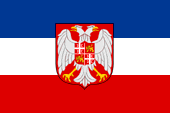
Staatsflagge,
Seitenverhältnis = 2:3,
zweifelhaft




Handelsflagge,
Seitenverhältnis = 2:3,
Quelle, nach:
1.) Wikipedia (EN),
2.) Wikipedia (EN)



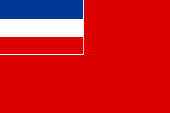
Marineflagge,
Seitenverhältnis = 2:3,
Quelle, nach: Flags of all Nations




Präsidentenstandarte,
Seitenverhältnis = 1:1,
Quelle, nach:
Wikipedia (EN)



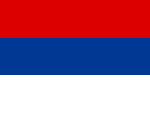
1992–2004,
Flagge von Serbien,
Seitenverhältnis = 1:2,
Quelle, nach: Flags of all Nations



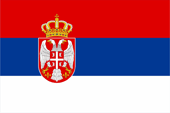
2004–2006,
Flagge von Serbien,
Seitenverhältnis = 2:3,
Quelle, nach: Wikipedia (D)






1992–2004,
Flagge von Montenegro,
Seitenverhältnis = 1:3,
Quelle, nach: Flags of all Nations



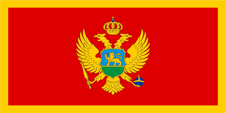
2004–2006,
Flagge von Montenegro,
Seitenverhältnis = 1:2,
Quelle, nach: Flags of all Nations







National-, Staats- und Handelsflagge,
Seitenverhältnis = 2:3,
Quelle, nach:
Wikipedia (EN)




Marine und Kriegsflagge,
Seitenverhältnis = 2:3,
Quelle, nach:
Wikipedia (EN)



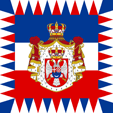
1918–1929 (?),
Standarte des Königs,
Seitenverhältnis = 1:1,
Quelle, nach:
Flags of the World



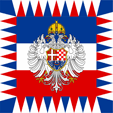
1929–1937 (?),
Standarte des Königs,
Seitenverhältnis = 1:1,
Quelle, nach:
Flaggenbuch 1939



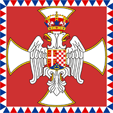
1937–1941 (?),
Standarte des Königs,
Variante,
Seitenverhältnis = 1:1,
Quelle, nach:
Flags of the World




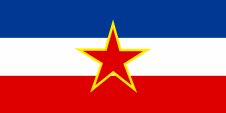
Nationalflagge,
Seitenverhältnis = 1:2,
Quelle, nach:
Wikipedia (EN)





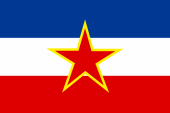
Handelsflagge,
Seitenverhältnis = 2:3,
Quelle, nach:
Wikipedia (EN)





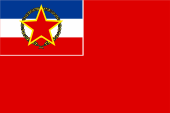
1946–1992,
Marineflagge,
Seitenverhältnis = 2:3,
Quelle, nach:
Flaggen und Wappen



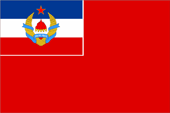
Ehrenflagge der Marine,
Seitenverhältnis = 2:3,
Quelle, nach:
Flags of the World



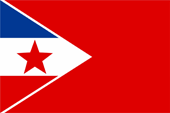
1956–1992
Flagge des Grenzschutzes,
Seitenverhältnis = 2:3,
Quelle, nach:
Flags of the World



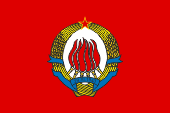
Gösch,
Seitenverhältnis = 2:3,
Quelle, nach:
Flags of the World



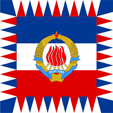
1963–1992,
Präsidentenstandarte,
Seitenverhältnis = 1:1,
Quelle, nach:
Flaggen und Wappen



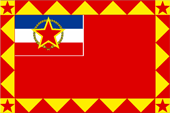
Standarte des Oberkommandierenden der Streitkräfte,
Seitenverhältnis = 2:3,
Quelle, nach:
Flags of the World




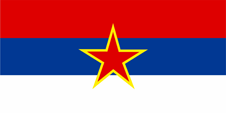
Flagge Serbiens und Flagge Montenegros,
Seitenverhältnis = 1:2,
Quelle, nach:
Wappen und Flaggen aller Nationen



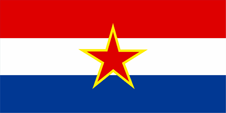
Flagge Kroatiens,
Seitenverhältnis = 1:2,
Quelle, nach:
Wappen und Flaggen aller Nationen



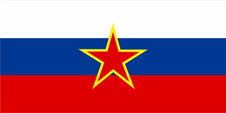
Flagge Sloweniens,
Seitenverhältnis = 1:2,
Quelle, nach:
Wappen und Flaggen aller Nationen



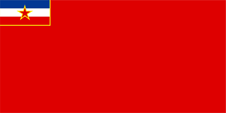
Flagge Bosnien-Herzegowinas,
Seitenverhältnis = 1:2,
Quelle, nach:
Wappen und Flaggen aller Nationen



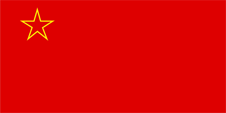
Flagge Makedoniens,
Seitenverhältnis = 1:2,
Quelle, nach:
Wappen und Flaggen aller Nationen




Die Flagge des 1918 entstandenen Königreichs der Serben, Kroaten und Slowenen (1918–1929)zeigte die Farben Blau, Weiß und Rot (panslawische Farben) in waagerechter Anordnung. Die Marine- und Kriegsflagge zeigte zusätzlich noch das mittlere Wappen des Landes. Über die Flagge des Königs findet man widersprüchliche Angaben und unterschiedliche Ausführungen. Als relativ sicher gilt eine blau-weiß-rote quadratische Flagge mit dem großen Wappen des Landes darin. Sie zeigte am Rand den von den Flaggen der Habsburger Monarchie her bekannten charakteristischen Rand aus Dreiecken, der sich in den Flaggen der Staatsoberhäupter einiger Nachfolgestaaten Jugoslawiens bis heute erhalten hat. Mindestens eine Quelle, das Flaggenbuch des Oberkommandos der Deutschen Kriegsmarine von 1939, zeigt für die 30-er Jahre in der Mitte der Flagge ein anderes Motiv, einen doppelköpfigen silbernen Adler unterhalb einer völlig anders gestalteten Krone mit einem Wappenschild auf der Brust, der anstelle der Symbolik von Bosnien diejenige von Slowenien (Krain) zeigt. Immerhin ist es möglich, dass diese Gestaltung im Jahre 1929 eingeführt wurde, als das Land in "Jugoslawien" umbenannt worden ist. Eine weitere, angeblich 1937 eingeführte Flagge des Königs zeigt außer dem leicht veränderten Dreiecks-Rand jetzt einen purpurfarbenen Hintergrund, in der Mitte ein großes silbernes Kreuz und darauf einen in seiner Gestalt veränderten silbernen Adler unter der üblichen Krone, mit dem üblichen Wappenschild auf der Brust. Der jugoslawische Staat zerfiel während des Zweiten Weltkrieges (1941) in drei Staaten (Serbien, Kroatien und Montenegro), bzw. wurden große Gebiete an Nachbarstaaten angegliedert. Im November 1945 hatten sich die kommunistischen Partisanen des Josip Broz Tito im Bürgerkrieg gegen Monarchisten, Republikaner und Nationalisten durchgesetzt, und proklamierten die "Föderative Volksrepublik Jugoslawien". Die Tito-Partisanen verwendeten seit 1941 einen goldumrandeten fünfzackigen roten Stern, welcher ab dem 21.01.1946 das bis dahin auf der Flagge verwendete Wappen ersetzte. Am 17.04.1963 wurde das land in "Sozialistische Föderative Republik Jugoslawien" umbenannt. Die Flagge blieb jedoch unverändert. Mit dem Zusammenbruch des sozialistischen Systems verließen zwischen 1991 und 1992 Slowenien, Kroatien, Makedonien und Bosnien-Herzegowina den jugoslawischen Staat. Am 27.04.1992 schlossen sich die beiden verbleibenden Staaten Serbien und Montenegro zur "Föderativen Republik Jugoslawien" zusammen, und der rote Stern wurde ersatzlos von der Nationalflagge entfernt und ein neues Staatswappen angenommen. Seit 2003 hieß das Land "Bundesrepublik Serbien und Montenegro". Am 03.06.2006 endete das Land mit dem Austritt Montenegros. Die Mitgliedsstaaten Jugoslawiens nutzten die Panslawischen Farben ihrer jeweilige Nationalflagge, nur wurde je nach dem politischen System entweder ein Landeswappen oder ein roter Stern in der Mitte der Flagge verwendet. Lediglich Bosnien-Herzegowina und Makedonien haben in der Zeit des sozialistischen Jugoslawiens jeweils eine anders gestaltete Flagge verwendet. Viele slawische Völker schufen sich in der Zeit nach 1848 (dem Jahr der Revolutionen) – im Zusammenhang mit einem erstarkenden slawischen Nationalismus – eigene Flaggen. Dabei spielte der Panslawismus eine bedeutende Rolle, eine politische Bewegung des 18./19. Jahrhunderts, die alle Slawen in einer Nation einen wollte. Die meisten slawischen Völker lebten jedoch in dieser Zeit unter österreichischer, türkischer oder auch deutscher Herrschaft. Der Panslawismus sah in Russland ein Vorbild, denn die Russen waren nahezu die einzige freie slawische Nation. Und so wurden die Farben der russischen Flagge zum Idol der Panslawisten, und letztlich farbliches Vorbild bei der Gestaltung der Flaggen vieler slawischer Nationen. Diese Flaggen trugen und tragen bis auf wenige Ausnahmen die russischen Farben Weiß, Blau und Rot als gemeinsames Merkmal. Daher wird diese Farbkombination "Panslawische Farben" genannt. Serbien hatte 1830 das osmanische Joch abgeworfen, und im Jahre 1835 die rot-blau-weiße Flagge angenommen. Montenegro (eine ursprünglich rein serbische Staatsgründung), 1852 vom Osmanischen Reich unabhängig geworden, verwendete zunächst eine rote Flagge mit einem silbernen Adler darin. Im Jahre 1860 schaffte Montenegro die rote Flagge mit dem Adler ab, und übernahm die Flagge Serbiens. Für die Einführung der Flagge Serbiens mit den russischen Farben wird zuweilen ein ganz konkreter Grund angeführt: Die Farben seien als Dank für die Waffenhilfe der Russen für die Serben im Freiheitskampf gegen die Türken angenommen worden.
Quelle:
Die Welt der Flaggen,
Flaggenbuch 1939,
Flaggen Wappen Hymnen

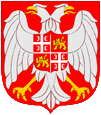
1992–2006,
Wappen von Jugoslawien
(seit 2003: Serbien und Montenegro),
Quelle, nach:
Corel Draw 4


1918–1941,
Wappen von Jugoslawien,
Quelle, nach:
Wikipedia (EN)
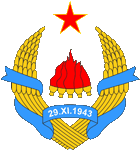
1943–1946,
Wappen von Jugoslawien (im Untergrund),
Quelle, nach:
Corel Draw 4,
Wikipedia (EN)
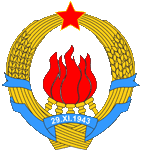
1946–1963,
Wappen von Jugoslawien,
Quelle, nach:
Corel Draw 4,
Wikipedia (EN)
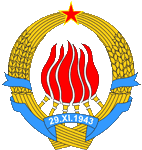
1963–1992,
Wappen von Jugoslawien,
Quelle, nach:
Corel Draw 4,
Wikipedia (EN)

Das Wappen des im Jahre 1918 gegründeten "Königreichs der Serben, Kroaten und Slowenen" – das 1929 in "Königreich Jugoslawien" umbenannt wurde – zeigt den silbernen serbischen Doppeladler auf rotem Grund, denn die Könige Serbiens waren zugleich die Könige Jugoslawiens. Der Adler trägt ein halbgespaltenes und halbgeteiltes Brustschild mit der Heraldik Serbiens (Kreuz mit Feuerstählen), Kroatiens (weiß-rot geschacht) und Sloweniens (Halbmond mit drei Sternen). Oberhalb des Schildes die jugoslawische Krone. Das Wappen des sozialistischen Jugoslawiens zeigte sechs Fackeln, die für die einzelnen Teilstaaten des Landes standen. Bis 1963 waren es nur fünf Fackeln, welche für die fünf Nationen des Landes standen. Über den Fackeln der fünfzackige, goldumrandete rote Stern der Tito-Partisanen, das Zeichen des Kommunismus. Die Fackeln sind von einem Ährenkranz umgeben, der von einem blauen Band zusammengehalten wird. Das Band trägt in der Mitte das Datum 29.11.1943. An diesem Tag wurde das kommunistische Volksbefreiungskomitee gegründet. Das bis zum Ende Jugoslawiens (seit 2003 Bundesrepublik Serbien und Montenegro) gültige Wappen zeigte wieder den serbischen (jugoslawischen) Doppeladler. Das viergeteilte Schild auf seiner Brust vereinte die Heraldik Serbiens (Kreuz mit Feuerstählen) und Montenegros (goldener schreitender Löwe).
Quelle:
Flaggen Wappen Hymnen,
Wikipedia (EN)

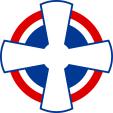
1929–1941,
Flugzeugkokarde,
Quelle, nach: Wikipedia (EN)
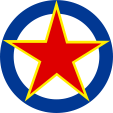
1945–1992,
Flugzeugkokarde,
Quelle, nach: Wikipedia (EN)
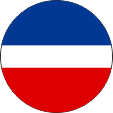
1992–2006,
Flugzeugkokarde,
Quelle, nach: Wikipedia (EN)

Die Staaten des früheren Jugoslawien:
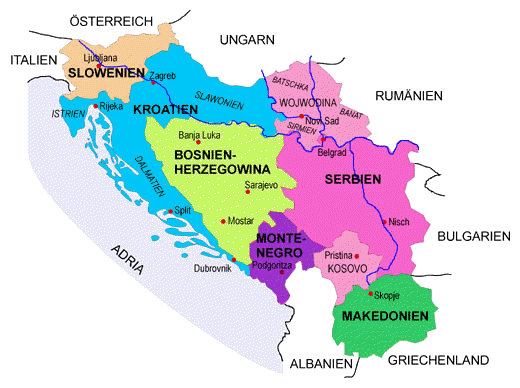
Landkarte/Map: Volker Preuß

Fläche: 255.804 km²
Einwohner: 22.800.000 (1981), davon 35 % Serben, 19 % Kroaten, 8 % Bosniaken, 8 % Slowenen, 7 % Albaner, 6 % Mazedonier, 3 % Montenegrinische Serben, 2 % Ungarn
Bevölkerungsdichte: 89 Ew./km²
Hauptstadt: Beograd (deutsch: Belgrad), 1.460.000 Ew. (1981)
Amtssprache: Serbisch/Kroatisch
sonstige Sprachen: Albanisch, Deutsch
Währung: 1 Jugoslawischer Dinar = 100 Para
Zeitzone: MEZ
Quelle:
Länder der Erde,
Wikipedia (D)

1830 · Serbien wird endgültig vom Osmanischen Reich unabhängig
1852 · Montenegro wird unabhängig
1878 · Beriner Kongress, Unabhängigkeit für Serbien und Montenegro wird bestätigt
1918 · Zusammenbruch der Habsburger Monarchie in Folge des Ersten Weltkrieges
01.12.1918 · Slowenen, Kroaten, Serben und Montenegriner schließen sich im "Königreich der Serben, Kroaten und Slowenen" zusammen, Bosnien-Herzegowina und Makedonien werden Provinzen, erster König wird Peter I. aus dem serbischen Königshaus Karadjordjevic
1921 · König Alexander I. folgt Peter I. auf den Thron
1929 · König Alexander I. errichtet eine Militärdiktatur, Umbenennung des Staats in "Königreich Jugoslawien"
1934 · König Alexander I. wird in Marseille ermordet, Thronfolger wird Peter II.
25.03.1941 · Jugoslawien erklärt seinen Beitritt zur den Achsenmächten (Achse), daraufhin Putsch serbischer Offiziere unter General Simovic, der Beitritt zur "Achse" wird widerrufen
06.04.1941 · Einmarsch deutscher und italienischer Truppen
17.04.1941 · Kapitulation Jugoslawiens, Jugoslawien wird aufgelöst: der König flieht ins Exil, einige Gebiete müssen an Nachbarstaaten abgetreten werden (Makedonien, Kosovo, Banat und Slowenien), die Provinz Bosnien-Herzegowina wird Kroatien angeschlossen, Kroatien und Montenegro werden unabhängig, Serbien kommt unter deutsche Militärverwaltung
15.06.1941 · Kroatien tritt der "Achse" bei
1941–1946 · Jugoslawien ist während des Zweiten Weltkriegs Schauplatz eines erbarmungslosen Partisanen- und Bürgerkriegs zwischen Kommunisten (unter J.P.Tito), Republikanern, Monarchisten und Nationalisten, die Kommunisten setzen sich durch
29.11.1945 · Ausrufung der "Föderativen Volksrepublik Jugoslawien" durch Tito
1945 · "Beistandspakt" mit der Sowjetunion
1948 · Bruch mit der Sowjetunion, Ablehnung deren Bevormundung, Entwicklung eines eigenen jugoslawischen Weges zum Sozialismus
17.04.1963 · Umbenennung in "Sozialistische Föderative Republik Jugoslawien"
04.05.1980 · Tod von J. B. Tito
1981 · Aufstände der Albaner im Kosovo, die Albaner fordern für die autonome serbische Provinz Kosovo den Republikstatus, die Aufstände werden niedergeschlagen
1990 · Wahl von Slobodan Milosevic zum Präsidenten Serbiens
1990 · Aufhebung des Autonomiestatus der serbischen Provinzen Kosovo und Wojvodina
25.06.1991 · Slowenien und Kroatien treten aus Jugoslawien aus und erklären ihre Unabhängigkeit
21.11.1991 · Makedonien tritt aus Jugoslawien aus und erklärt seine Unabhängigkeit
01.03.1992 · Bosnien-Herzegowina tritt aus Jugoslawien aus und erklärt seine Unabhängigkeit
27.04.1992 · Serbien und Montenegro proklamieren die "Bundesrepublik Jugoslawien"
1991–1995 · Krieg zwischen Jugoslawien und Kroatien/Bosnien-Herzegowina
1998 · im Kosovo forciert die UÇK (Albanische Befreiungsarme des Kosovo) ihren Kampf für die staaliche Unabhängigkeit des Kosovo, auf Grund der serbischen Gegenmaßnahmen fliehen viele Albaner aus Kosovo
1999 · die NATO ergreift einseitig Partei für die UÇK, greift in der Krieg Serbiens um seine territoriale Integrität ein, und bombardiert großangelegt serbische Ziele im Kosovo sowie in Serbien selbst, Besetzung des Kosovo durch KFOR-Truppen der NATO zum "Schutz vor Übergriffen jugoslawischer Truppen", Vertreibung der serbischen Bevölkerung aus dem Kosovo
2000 · Wahlen in Serbien, Vojislav Kostunica wird Nachfolger von Milosevics
28.06.2001 · die serbische Regierung verkauft Slobodan Milosevic gegen Wirtschaftshilfe und mehrere Millionen Dollar an das UN-Kriegsverbrechertribunal in Den Haag
2002 · die serbische Provinz Kosovo wählt einen "Präsidenten", Ibrahim Rugova
04.02.2003 · neue Verfassung, Jugoslawien wird durch die "Bundesrepublik Serbien und Montenegro" abgelöst
21.05.2006 · Volksabstimmung in Montenegro über eine Trennung Montenegros von Serbien, 55,4% Zustimmung zur Auflösung des Staatenbundes
13.07.2006 · Unabhängigkeitserklärung von Montenegro, Ende des Staatenbundes
Quelle:
Atlas zur Geschichte,
Discovery '97,
Wikipedia (D)


![]()











































































